The Egret bird is a beautiful, white-feathered bird commonly found in Florida. Known for its long neck and legs, the Egret loves to spend time near water, like lakes, rivers, and wetlands. It gracefully wades through the water, hunting for fish and other small creatures. This bird is a common sight in Florida’s natural parks and is admired for its elegance and peaceful presence. Many people enjoy watching Egrets as they add beauty to Florida’s landscapes.
Egret Bird in Florida
The Egret bird in Florida is a white, long-necked bird often seen near water. It hunts for fish and other small animals in lakes, rivers, and wetlands. Egrets are common in Florida’s parks and natural areas, known for their graceful movements and beautiful appearance.
The Egret Bird in Florida: A Complete Guide
Florida is home to many wonderful animals, and among the most beautiful are the egrets. These long-legged birds are often seen walking through the state’s wetlands, marshes, and along the coast. In this guide, we will explore the different types of egrets in Florida, their habitats, behaviors, and their importance in nature. Let’s dive deep into the world of these elegant birds and learn everything about them.
What is an Egret?
Egrets are large, long-necked birds that belong to the heron family (Ardeidae). They are best known for their white feathers, long legs, and graceful necks. Even though they are often mistaken for other birds, their slow, elegant movements make them easy to recognize. Egrets are skilled hunters, using their sharp beaks to catch fish, insects, and small animals in the water. Florida, with its wide areas of wetlands and coastal regions, is the perfect place for these birds to live and thrive.
Types of Egrets in Florida
- Great Egret
- Snowy Egret
- Cattle Egret
- Reddish Egret
Florida is home to several types of egrets, each with unique features. Below, we’ll look at the different types of egrets found in Florida, describing their size, appearance, behavior, and where you can find them.
1. Great Egret
The Great Egret is the largest egret in Florida. This tall bird can reach up to 3.3 feet in height and has a wingspan of around 5 feet. It has white feathers, a yellow beak, and black legs, making it easy to spot. The Great Egret is often seen walking slowly through shallow water, looking for fish and other small animals to catch.
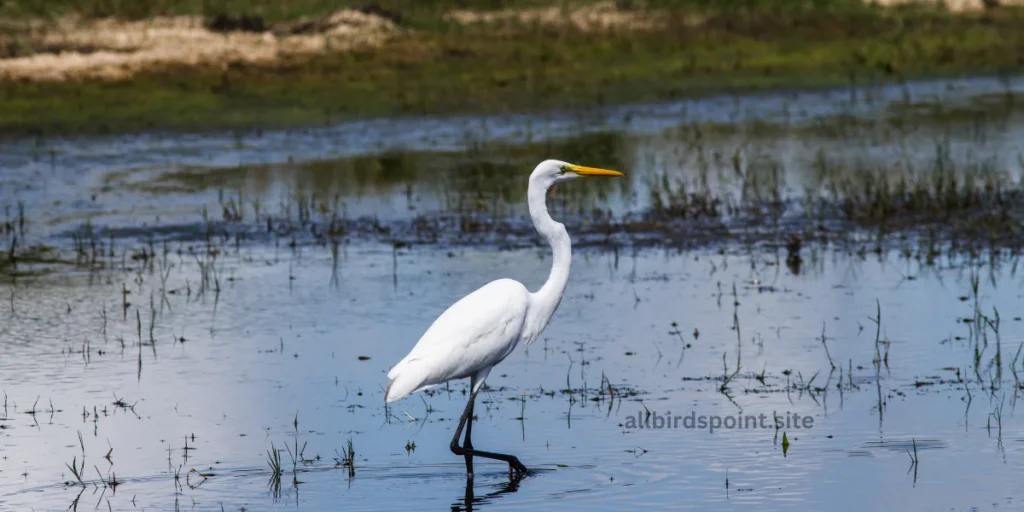
Habitat and Behavior:
- Habitat: The Great Egret lives in wetlands, rivers, and coastal areas.
- Diet: This bird eats fish, small mammals, amphibians, and crustaceans.
- Breeding Season: Great Egrets breed in the spring and summer.
During the breeding season, Great Egrets grow long, beautiful feathers called “plumes” on their backs. These plumes were once used to make fancy hats, which led to the hunting of these birds in the past. Today, they are protected, and their populations have grown back.
| Characteristic | Description |
|---|---|
| Height | About 3.3 feet |
| Wingspan | Up to 5 feet |
| Features | White feathers, yellow bill, black legs |
| Diet | Fish, amphibians, crustaceans |
2. Snowy Egret
The Snowy Egret is a smaller but equally stunning bird. This egret is about 2 feet tall and has pure white feathers, a black beak, and bright yellow feet. Snowy Egrets are known for their active hunting style; they often move their feet in the water to stir up prey like fish and shrimp.
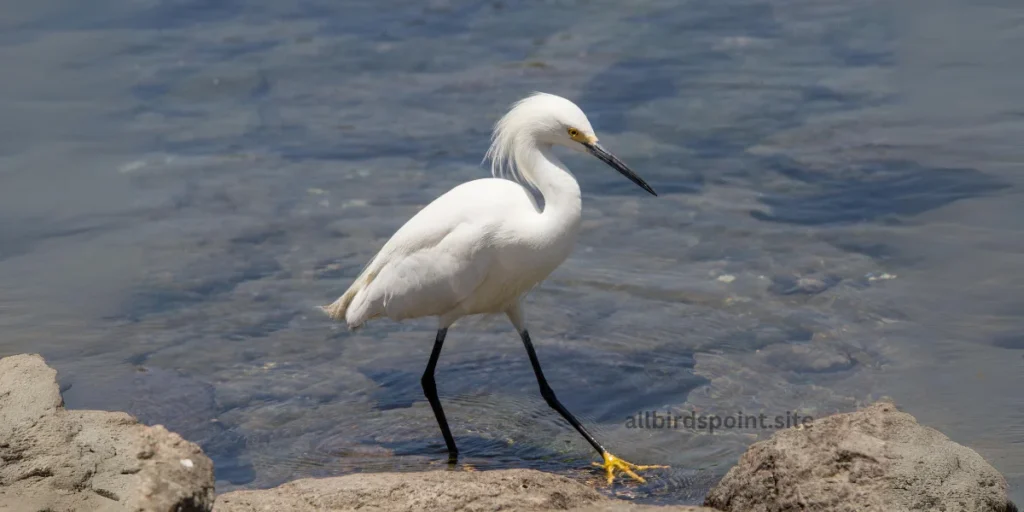
Habitat and Behavior:
- Habitat: Snowy Egrets live in wetlands, marshes, and shallow coastal areas.
- Diet: They feed on small fish, insects, frogs, and other small creatures.
- Breeding Season: Late spring to early summer is the time for nesting.
Snowy Egrets are social birds and can often be seen nesting in large groups with other wading birds. Their beautiful, wispy feathers become even more striking during the breeding season, and they use them to attract mates.
| Characteristic | Description |
|---|---|
| Height | About 2 feet |
| Key Features | White feathers, black beak, yellow feet |
| Diet | Fish, frogs, insects |
| Behavior | Active hunter, uses feet to stir prey |
3. Cattle Egret
The Cattle Egret is different from other egrets because it is usually seen far from water. This bird spends a lot of time in fields and farms, following cattle or other animals to catch insects stirred up by their movement. The Cattle Egret is smaller than other egrets, standing about 1.5 feet tall. It is mostly white, but during the breeding season, it develops orange feathers on its head, chest, and back.
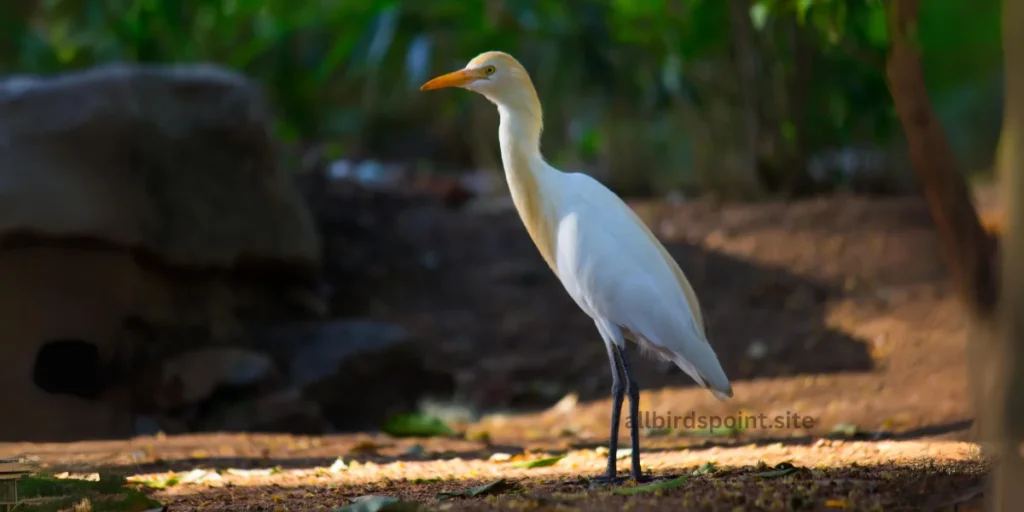
Habitat and Behavior:
- Habitat: Cattle Egrets prefer grasslands, farmlands, and pastures.
- Diet: They eat insects, small mammals, and amphibians.
- Breeding Season: Cattle Egrets breed in the spring and summer, often nesting in trees near water.
Cattle Egrets are highly adaptable and have spread across Florida’s farmlands and grasslands. They are often seen following cattle or even tractors, as both stir up insects, making it easier for the egrets to hunt.
| Characteristic | Description |
|---|---|
| Height | About 1.5 feet |
| Key Features | Stocky build, white feathers with orange breeding plumage |
| Diet | Insects, small mammals, amphibians |
| Behavior | Often found around cattle and livestock |
4. Reddish Egret
The Reddish Egret is one of the more colorful egrets in Florida. It has a reddish-brown neck and a bluish-gray body, making it stand out from the others. Unlike most other egrets, the Reddish Egret is very active when hunting, often running, jumping, and flapping its wings to scare fish into the shallows. This bird is a rare but exciting sight in Florida.
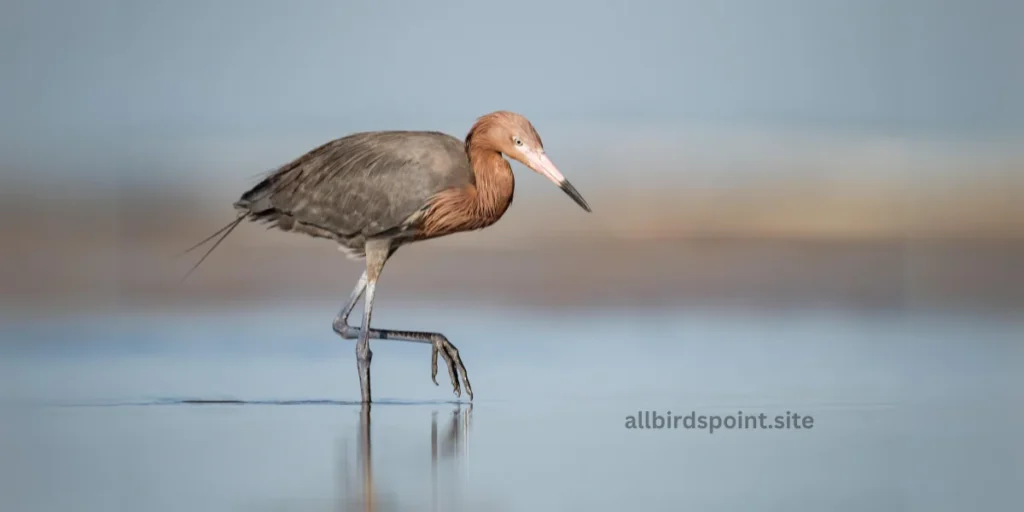
Habitat and Behavior:
- Habitat: Reddish Egrets live along the coast, in salt flats, estuaries, and mangroves.
- Diet: They primarily eat fish, which they catch using their unique hunting technique.
- Breeding Season: Reddish Egrets breed in the summer and often nest in coastal mangroves.
Reddish Egrets are more solitary than other egrets, preferring to hunt alone. They are also less common, so spotting one is always a treat for birdwatchers. Their unique hunting style is fun to watch, as they dart and dance across the water in search of food.
| Characteristic | Description |
|---|---|
| Height | About 2.5 feet |
| Key Features | Reddish-brown neck, bluish-gray body |
| Diet | Fish |
| Behavior | Active, dramatic hunter |
Egret Habitats in Florida
Egrets thrive in Florida because of the state’s abundance of wetlands, marshes, and coastal areas. These environments are rich in the fish, frogs, and small animals that egrets feed on. Below are the most common habitats where you can find egrets in Florida.
1. Wetlands and Marshes
Wetlands are crucial to egrets. These areas provide the shallow waters egrets need to hunt and the trees or bushes where they nest. The Everglades, one of the most famous wetlands in the world, is home to many egret species, including the Great Egret and Snowy Egret.
| Wetland Regions in Florida | Egret Species Found |
|---|---|
| Everglades | Great Egret, Snowy Egret |
| St. Johns River Marsh | Cattle Egret, Great Egret |
| Merritt Island Wildlife Refuge | Snowy Egret, Reddish Egret |
2. Coastal Areas
Florida’s coastlines offer the perfect environment for egrets, especially the Reddish Egret, which prefers saltwater habitats. Estuaries, mangroves, and tidal flats provide plenty of shallow water where egrets can hunt.
3. Farmlands and Grasslands
Cattle Egrets are more often seen in dry areas like fields and farmlands. These birds are drawn to areas with grazing livestock because they eat the insects that cattle stir up. They are highly adaptable and can live in both rural and urban settings.
Egret Behavior
Egrets are fascinating birds with interesting behaviors, especially when it comes to hunting and nesting. Each egret species has its own unique behaviors, which make them fun to watch and study.
1. Hunting Techniques
Egrets are skilled hunters, each with its own style. The Great Egret is patient, standing still for long periods before striking at prey. The Snowy Egret uses its yellow feet to stir up water, making it easier to find fish. The Reddish Egret is the most active, chasing fish with quick movements, often leaping and flapping its wings to herd them into shallower water.
2. Nesting and Breeding
Egrets usually nest in colonies, often alongside other wading birds like herons. They build their nests in trees or bushes, usually near water. The nests are made from sticks and other plant materials. During the breeding season, the birds’ feathers become brighter and more colorful, making them more attractive to mates. Both parents help incubate the eggs, which hatch after about three weeks.
Importance of Egrets in the Ecosystem
Egrets play an important role in Florida’s ecosystems. By eating fish, insects, and small animals, they help control the population of these creatures, keeping the food chain balanced. Egrets are also a good sign of a healthy environment because they need clean water and enough food to survive. When egret populations are thriving, it usually means the surrounding environment is in good shape.
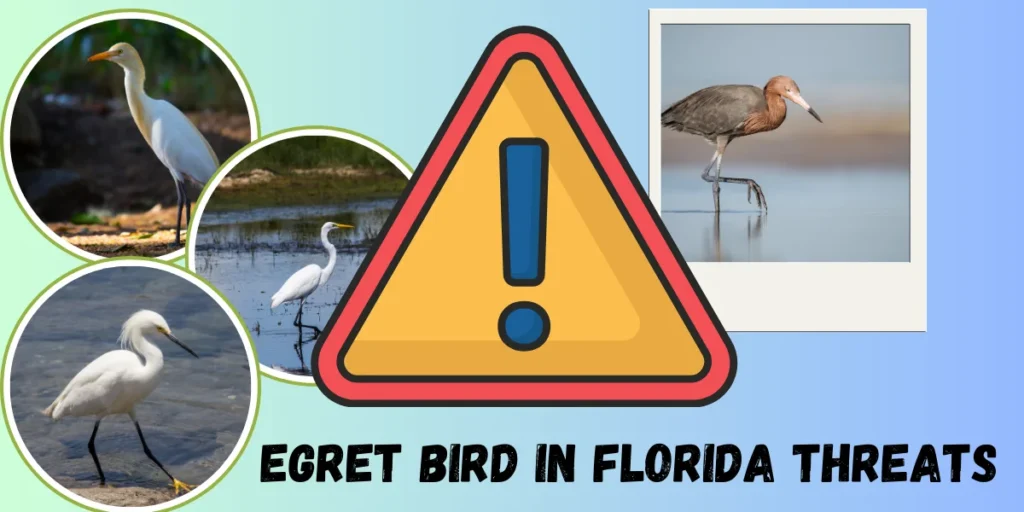
Threats to Egret Populations
While egrets are common in Florida, they face several threats. Here are some of the main challenges they encounter:
1. Habitat Loss
As Florida’s wetlands and coastal areas are developed for homes, businesses, and agriculture, egrets lose the places they rely on for feeding and nesting. This can cause a drop in their populations.
2. Pollution
Water pollution from chemicals, pesticides, and runoff can harm egrets by contaminating their food sources. When fish and other prey are poisoned by chemicals, the egrets that eat them can also become sick.
3. Climate Change
Rising sea levels and changing weather patterns caused by climate change are affecting the habitats of Florida’s egrets. Coastal areas are particularly vulnerable to flooding, which can destroy nesting sites. Additionally, changes in water temperature can affect the availability of fish, making it harder for egrets to find enough food.
Conservation Efforts
Efforts are being made to protect Florida’s egrets and their habitats. Organizations such as the Audubon Society and Florida Fish and Wildlife Conservation Commission work to preserve wetlands, reduce pollution, and restore habitats. Public education and awareness are also important, as many Floridians and visitors enjoy watching these graceful birds and want to help protect them.
How to Spot Egrets in Florida
Egrets are relatively easy to spot in Florida, especially because of their large size and bright white feathers. If you’re interested in birdwatching, here are some tips for spotting egrets in their natural environment:
1. Visit Wetlands and Coastal Areas
The best places to see egrets are Florida’s wetlands, marshes, and coastlines. The Everglades, Merritt Island National Wildlife Refuge, and the St. Johns River Marsh are just a few locations where you can find these birds.
2. Use Binoculars
While egrets are often easy to see with the naked eye, binoculars can help you get a closer look at their unique behaviors, like hunting and nesting, without disturbing them.
3. Look for Groups of Birds
Egrets often share their habitat with other wading birds, such as herons and ibises. If you spot a group of birds standing in shallow water, there’s a good chance that egrets will be among them.
Conclusion
Egrets are one of the most graceful and beautiful birds found in Florida. Their elegance, combined with their importance to the ecosystem, makes them a key species in the state’s natural environment. By learning more about these amazing birds, we can better appreciate the role they play in Florida’s ecosystems and support efforts to protect their habitats. Whether you’re an avid birdwatcher or simply someone who enjoys nature, taking the time to observe egrets in their natural environment is a rewarding experience.
Egrets in Florida remind us of the importance of preserving natural habitats and protecting wildlife for future generations.
FAQs: Egret Bird in Florida
1. What types of egrets are found in Florida?
Florida is home to several egret species, including the Great Egret, Snowy Egret, Cattle Egret, and Reddish Egret.
2. Where do egrets live in Florida?
Egrets are commonly found in wetlands, marshes, coastal areas, and farmlands across Florida.
3. What do egrets eat?
Egrets mainly eat fish, insects, frogs, and small mammals.
4. When is egret breeding season?
Most egrets in Florida breed during spring and summer.
5. Are egrets protected in Florida?
Yes, egrets are protected by wildlife conservation laws to prevent habitat loss and ensure their survival.
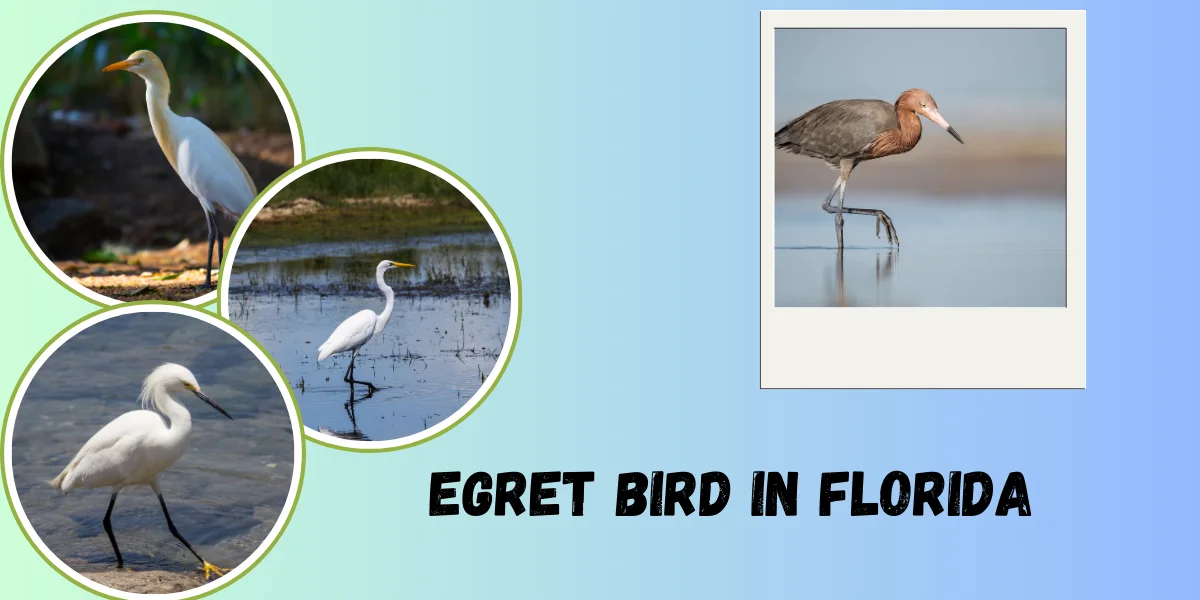
1 thought on “Egret Bird in Florida: Complete Guide to Species and Habitats”